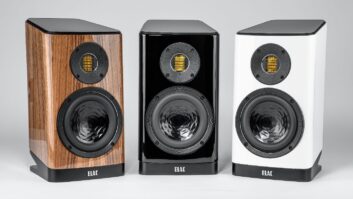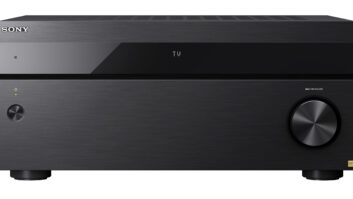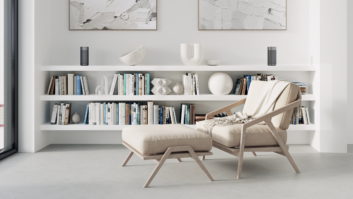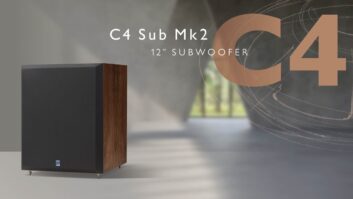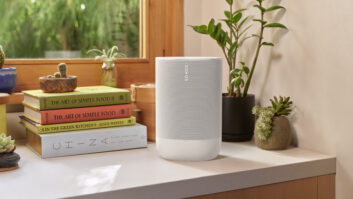Change, progress, and improvement are the basic hallmarks of the consumer electronics industry. The goal is that each new generation of product will feature some worthwhile upgrade or improvement to keep the product relevant and cutting edge.
It has been nearly 18 months since I looked at Bluesound’s high-resolution streaming music system, and it’s clear that the company’s engineers and designers have been hard at work in that time period. Gen 2 really reminds me of Apple’s latest iPhone slogan: “The only thing that’s changed is everything.” Well, almost everything, because the great sound and control app have remained. Nearly every component in the system–save for the Pulse tabletop speaker–has been completely redesigned, and the company clearly listened to feedback from users and incorporated these suggestions to make its Gen 2 product offering more impressive in virtually every regard.
Most clearly different is the hardware form-factor. The previous iteration of Bluesound’s Vault, PowerNode, and Node featured an unusual, wedge-shaped design that, while visually striking, didn’t exactly lend itself to traditional rack installations. The new Gen 2 versions of these products have all been redesigned with a far more compact look, and now sit flat and share a common 8.7-inch width, meaning that two of any of these components will easily fit side-by-side on a rack shelf. If creating housewide audio distribution systems with stacks of sources (Node 2) connected to multi-channel amps, or amplified players (PowerNode 2) in a rack, then Bluesound’s new design will be right up your alley. All components also now feature capacitive touch buttons on top offering local volume up/down, play/pause, and track skip forward/back. (At the time of review, the play/pause button incorrectly functioned as a mute toggle.)

Bluesound’s Gen 2 high-resolution streaming music system
The connections also have been improved all around, with all units now featuring a mini-jack input that accepts either analog or optical digital audio signals. (A mini-to-To-slink adapter is included with each component.) All components feature a mini-jack headphone output with dedicated amplifier. (I didn’t use this much, but connected a pair of Velodyne vTrue Studio phones to confirm that the system could indeed power and coax bass from the big 50mm drivers.) The ethernet jack has been upgraded throughout to Gigabit speed, and the Node 2 and Vault 2 both offer coaxial digital audio outputs along with Toslink.
Plenty of improvements have been made under the hood, as well, with all Gen 2 products receiving a hefty processor upgrade in the form of a 1 GHz multi-core ARM Cortex-A9, which improves performance over 50 percent compared with the previous A8. While Bluetooth was supported via an optional dongle in the past, all components now boast onboard Bluetooth 4.0 with aptX.
Upgrades have been made on the audio side as well, with devices featuring new OPAmps and 32 bit DACs. These upgrades result in an SNR improvement from 100 to 110 dB. The Vault 2 gets a bump to 2 terabytes of storage while the PowerNode 2 gets a more powerful, 60×2 amplification. All units still handle high-resolution audio files up to 192/24-bit, with a nice little purple “HD” logo notifying you whenever you are listing to a better-than-CD quality track. It’s also important to mention that all Gen 1 and Gen 2 products are inter-compatible and can operate in the same system.
Installation is a breeze, being done entirely via the app. You start by tapping on “New Player Setup,” which walks you through the process of essentially opening your device’s wireless settings, connecting to the new player, and then navigating to “setup.bluesound.com.” There you enter your Wi-Fi’s credentials into the player, it connects, and you’re done. From the setup menu you also get a ton of other options like naming the player, configuring audio settings like fixed or variable output, or whether it is stereo or mono, Bluetooth connection options, add network shares, set indicator brightness, configure IR triggers, and more.
The most noticeable improvement on the user side is the addition of more streaming services. And by “more” I mean “way more.” The system launched supporting only three, but now supports 15 with Apple Music and Google Play on the horizon. Oddly, Bluesound still doesn’t support Pandora, which might be a bummer to some. However, with Bluetooth streaming on every component, it certainly wouldn’t be trouble to just beam Pandora–or Songza or whatever–to any and all players.
My favorite component remains the Vault 2, as it makes the Bluesound ecosystem a computer-free affair. With this, users simply insert CDs into the front-loading slot and in about 10 minutes have the new music automatically added to their library. Users with existing collections can simply “drag” the music to the Vault 2 across the network, or just “point” it at the network location of the stored music. The Vault 2 can also be linked to sites like HDtracks.com to download content directly to its internal drive. The Vault 2 is really a great component for any non-computer-savvy music lovers. The Vault 2 does require a hardwired ethernet connection to the home’s network, being the only component that can’t operate wirelessly.
Sonically, the system sounds absolutely first rate and would be a terrific complement to audio systems of any caliber. I connected the Vault 2 to my Marantz AV8802a preamp via both coaxial digital and analog to compare the sound quality of the Bluesound’s DAC to the Marantz. Going back and forth I found the sound to be incredibly similar; that’s no small feat considering the Marantz is a $4,000 unit! The analog connection offered perhaps a touch more warmth and low end, while the digital offered a little more high-frequency detail and sonic width. Bottom line, both sounded terrific. Also, unlike some other systems, the Vault 2 easily handles gapless albums, like “Dark Side of the Moon,” seamlessly transitioning from track to track.
The amp in the PowerNode 2 is incredibly capable, easily driving a pair of Monitor Audio CP-WT380IDC with 8-inch drivers. The PowerNode 2 produced tangible bass from a speaker that I have found to be fairly demanding and amp hungry, easily driving them to levels loud enough to satisfy any listener. Adding Monitor’s in-wall sub not only produced an amazing two-channel experience, but it was incredibly simple using the sub-out connection and simply checking “with subwoofer” in the speaker configuration, automatically inserting a 12dB/octave filter at 80 Hz.
The Pulse Mini is a sonic marvel, with audio output that greatly belies its size. At just over 6 inches tall and 13 inches wide, it sits pretty demurely on a kitchen counter…until you start feeding it an audio signal. There is a bass note at the beginning of Macklemore and Ryan Lewis’ “Downtown” that goes virtually unnoticed on most systems without a sub, but the Pulse Mini found the deep note and hit it. Beyond just playing deep, it is articulate and detailed, and two of them can be turned into a stereo pair in larger rooms.
There’s not much to say about the Node 2. It offers all the connections you need, including a 12-volt trigger that’s useful for turning an amplifier on/off. I connected it to a Niles multi-channel amp that drove a pair of Origin Acoustics D104 speakers, and it performed exactly as it should.
Bluesound included a couple of cool custom install-friendly features as well, such as IR triggering and automation integration (currently limited to Control4, but with plans to expand). With IR triggering you can teach any of the components IR commands from any handheld remote. This is useful for, say, automatically turning the Bluesound PowerNode 2 amp on and setting it to the optical input when you power on a TV and having it respond to the TV’s volume commands.
I could go on and on. Like how great the iPad app is designed, with the screen intuitively sectioned to show a ton of useful information and give easy access to all the features. Or how easily you can build a playlist mixing and matching music from your library, and any/all on-line services. Or how the new sleep and alarm timers let you drift off or wake to your favorite music. Or how NAD and PSB will be integrating Bluesound into upcoming products, expanding the BluOS world. But ultimately I’m going to just finish with this: Bluesound is the best sounding, most enjoyable wireless music system that I’ve reviewed.
800.263.4641
bluesound.com
Kudos
Terrific sound quality; no computer required; well-designed app
Concerns
Lack of Pandora may bother some
Product Specs
► All components decode MP3, AAC, WMA, OGG, WMA-L, FLAC, ALAC, WAV, AIFF files up to 192/24 quality
► System supports up to 34 players, maximum 8 connected via WiFi
► Controlled via free iOS, Android, Kindle app or via Mac or PC utility
► System supports Deezer, HDtracks, High Res Audio, iHeart Radio, Juke, Murfie, Naptster, Qobuz, Rdio, Rhapsody, Slacker, Spotify, Tidal, TuneIn, WiMP; Bluetooth 4.0 with aptX
► Vault 2 includes CD ripper and 2 TB drive; must be connected via Ethernet; RCA analog, Toslink and coaxial digital outputs, USB-A (x2); mini-jack (optical or analog) input; headphone output; 12-volt trigger output; mini-jack IR input
